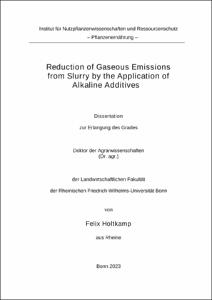Holtkamp, Felix: Reduction of Gaseous Emissions from Slurry by the Application of Alkaline Additives. - Bonn, 2023. - Dissertation, Rheinische Friedrich-Wilhelms-Universität Bonn.
Online-Ausgabe in bonndoc: https://nbn-resolving.org/urn:nbn:de:hbz:5-73437
Online-Ausgabe in bonndoc: https://nbn-resolving.org/urn:nbn:de:hbz:5-73437
@phdthesis{handle:20.500.11811/11178,
urn: https://nbn-resolving.org/urn:nbn:de:hbz:5-73437,
doi: https://doi.org/10.48565/bonndoc-175,
author = {{Felix Holtkamp}},
title = {Reduction of Gaseous Emissions from Slurry by the Application of Alkaline Additives},
school = {Rheinische Friedrich-Wilhelms-Universität Bonn},
year = 2023,
month = dec,
note = {The agricultural sector is undergoing a profound transformation process to meet international and national regulations and laws. These are being enacted by policymakers to limit the sector's tremendous gaseous emissions in an effort to reduce anthropogenic global warming and limit the effects of climate change. In this process, the improvement of slurry management strategies, i.e. the storage and application of slurry, is of particular importance, as this sector is one of the main sources of greenhouse gas emissions such as methane (CH4) and nitrous oxide (N2O) and of the environmentally harmful gas ammonia (NH3). Therefore, this dissertation investigates and evaluates two different slurry treatment strategies based on the application of alkaline additives with the aim to reduce these emissions.
In the first study, a new mathematical tool is presented that allows the visualization of the main buffer systems in slurry. It facilitates the characterization of the buffer system and reveals their underlying dynamics. The knowledge gained contributes to the optimization of mitigation strategies relying on pH adjustment by the application of alkaline additives. This tool was successfully verified by more than 300 titrations of slurry stored at different temperatures and for different periods. The collected data revealed that buffer systems are subject to significant fluctuations during storage, which are greatly influenced by temperature. These fluctuations are caused by dynamic formation and degradation processes that are interrelated and thus form a complex system.
The second study of this dissertation implements and assesses the first slurry treatment strategy, which is based on the application of calcium hydroxide (Ca(OH)2) as an alkaline additive to increase the pH value of the slurry. The study results demonstrated that during a storage period of 8 weeks and a pH value of 10, the emissions of CH4 and CO2 were reduced by 99% and these of N2O by 60%, while a further increment did not cause a greater reduction. In addition, the framework conditions that must be adhered to for this strategy to be implemented successfully are outlined.
The third study presents the second slurry treatment strategy in which calcium cyanamide (CaCN2) is utilized as a slurry additive to reduce gaseous emission during a long-term storage period of 26 weeks. It was demonstrated that CaCN2 suppressed CH4 emissions rapidly and long-lasting, resulting in a reduction potential of total greenhouse gas emissions by up to 99% over the entire storage period. Furthermore, it was shown that the application inhibited the microbial conversion of volatile fatty acids to CH4, which caused the pH to drop during storage, resulting in a reduction of NH3 emissions.},
url = {https://hdl.handle.net/20.500.11811/11178}
}
urn: https://nbn-resolving.org/urn:nbn:de:hbz:5-73437,
doi: https://doi.org/10.48565/bonndoc-175,
author = {{Felix Holtkamp}},
title = {Reduction of Gaseous Emissions from Slurry by the Application of Alkaline Additives},
school = {Rheinische Friedrich-Wilhelms-Universität Bonn},
year = 2023,
month = dec,
note = {The agricultural sector is undergoing a profound transformation process to meet international and national regulations and laws. These are being enacted by policymakers to limit the sector's tremendous gaseous emissions in an effort to reduce anthropogenic global warming and limit the effects of climate change. In this process, the improvement of slurry management strategies, i.e. the storage and application of slurry, is of particular importance, as this sector is one of the main sources of greenhouse gas emissions such as methane (CH4) and nitrous oxide (N2O) and of the environmentally harmful gas ammonia (NH3). Therefore, this dissertation investigates and evaluates two different slurry treatment strategies based on the application of alkaline additives with the aim to reduce these emissions.
In the first study, a new mathematical tool is presented that allows the visualization of the main buffer systems in slurry. It facilitates the characterization of the buffer system and reveals their underlying dynamics. The knowledge gained contributes to the optimization of mitigation strategies relying on pH adjustment by the application of alkaline additives. This tool was successfully verified by more than 300 titrations of slurry stored at different temperatures and for different periods. The collected data revealed that buffer systems are subject to significant fluctuations during storage, which are greatly influenced by temperature. These fluctuations are caused by dynamic formation and degradation processes that are interrelated and thus form a complex system.
The second study of this dissertation implements and assesses the first slurry treatment strategy, which is based on the application of calcium hydroxide (Ca(OH)2) as an alkaline additive to increase the pH value of the slurry. The study results demonstrated that during a storage period of 8 weeks and a pH value of 10, the emissions of CH4 and CO2 were reduced by 99% and these of N2O by 60%, while a further increment did not cause a greater reduction. In addition, the framework conditions that must be adhered to for this strategy to be implemented successfully are outlined.
The third study presents the second slurry treatment strategy in which calcium cyanamide (CaCN2) is utilized as a slurry additive to reduce gaseous emission during a long-term storage period of 26 weeks. It was demonstrated that CaCN2 suppressed CH4 emissions rapidly and long-lasting, resulting in a reduction potential of total greenhouse gas emissions by up to 99% over the entire storage period. Furthermore, it was shown that the application inhibited the microbial conversion of volatile fatty acids to CH4, which caused the pH to drop during storage, resulting in a reduction of NH3 emissions.},
url = {https://hdl.handle.net/20.500.11811/11178}
}






